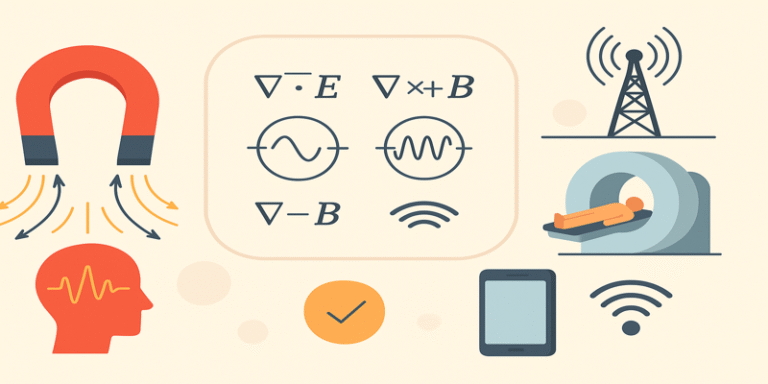Among the fundamental forces that govern our universe, electromagnetism stands as one of the most transformative. It explains how electric charges, magnetic fields, and electromagnetic waves interact, and its principles underpin a vast array of modern technologies. From power generation and wireless communication to medical imaging and brainwave analysis, electromagnetism continues to power human advancement.
Though phenomena like static electricity and magnetism have been observed since ancient times, it wasn’t until the 19th century that these were understood as manifestations of a single, unified force. This unification was achieved through the groundbreaking work of physicist James Clerk Maxwell, whose Maxwell’s equations provided a mathematical framework uniting electricity and magnetism into a coherent theory (Griffiths, 2017).
The Foundations of Electromagnetism
At its core, electromagnetism deals with the behaviour of charged particles and the fields they produce. These fields—electric and magnetic—interact according to specific physical laws. The key quantities in this theory include:
- Electric field (E): A field produced by electric charges or changing magnetic fields.
- Magnetic field (B): Generated by moving charges or changing electric fields.
- Electric current: The movement of charges, which generates magnetic effects.
These interactions are governed by four equations known collectively as Maxwell’s equations, which synthesise the work of Faraday, Gauss, Ampère, and Maxwell himself.
Maxwell’s Equations: A Unified Theory
Maxwell’s equations describe how electric and magnetic fields are generated and altered by each other and by charges and currents. They are:
- Gauss’s Law – Electric charges produce electric fields.
- Gauss’s Law for Magnetism – There are no magnetic monopoles; magnetic field lines always form closed loops.
- Faraday’s Law of Induction – A changing magnetic field induces an electric field.
- Ampère-Maxwell Law – Electric currents and changing electric fields generate magnetic fields.
Together, these equations predict the existence of electromagnetic waves—oscillations of electric and magnetic fields that propagate through space at the speed of light (Purcell & Morin, 2013).
Electromagnetic Waves and the Speed of Light
One of Maxwell’s most profound insights was that light itself is an electromagnetic wave. By solving his equations in a vacuum, Maxwell discovered that these waves travel at approximately 3 x 10⁸ m/s—the same as the measured speed of light. This led to the realisation that visible light, radio waves, X-rays, and microwaves are all part of the electromagnetic spectrum.
This revelation not only unified optics with electricity and magnetism but also paved the way for modern telecommunications, including radio, television, Wi-Fi, and satellite communication (Ulaby & Ravaioli, 2022).
Key Applications of Electromagnetism
1.0 Electrical Power Generation and Transmission
One of the most important uses of electromagnetism lies in the generation and distribution of electrical power. In power stations, turbines convert mechanical energy (from water, steam, or wind) into electrical energy using electromagnetic induction—the principle discovered by Michael Faraday in 1831. When a conductor moves through a magnetic field, an electric current is induced (Serway & Jewett, 2018).
Transformers, essential for the power grid, use changing magnetic fields to increase or decrease voltage levels for efficient transmission across long distances.
2.0 Wireless Communication
Every wireless device—from smartphones and radios to satellite dishes—relies on the principles of electromagnetism. Information is encoded onto electromagnetic waves (such as radio or microwaves) through modulation techniques. These waves propagate through the atmosphere or space, carrying data over vast distances.
The development of antenna theory, signal processing, and electromagnetic field modelling has been critical to enabling 5G, GPS, and Bluetooth technologies (Balanis, 2016).
3.0 Medical Imaging: MRI and Beyond
In the medical field, magnetic resonance imaging (MRI) stands as a remarkable application of electromagnetism. MRI uses strong magnetic fields and radiofrequency (RF) pulses to excite hydrogen nuclei in the body. As these nuclei return to their original state, they emit signals that are transformed into detailed images of soft tissues (Bushong, 2017).
Electromagnetism is also central to electrocardiograms (ECGs) and electroencephalograms (EEGs), which detect electrical activity in the heart and brain, respectively.
4.0 Brainwaves and Neuroscience
Brain activity produces weak electrical currents that generate measurable electromagnetic fields. These are typically studied using electroencephalography (EEG), which records brainwaves across different frequency bands such as alpha, beta, and theta.
This electromagnetic understanding has expanded into areas such as:
- Neurofeedback therapy
- Brain-computer interfaces (BCIs)
- Non-invasive brain stimulation techniques, like transcranial magnetic stimulation (TMS) (Thut et al., 2011)
Thus, electromagnetism enables both the monitoring and modulation of brain activity, providing novel approaches to treating neurological disorders.
Historical Development
The journey towards understanding electromagnetism was not linear. Key milestones include:
- Hans Christian Ørsted (1820) discovered that electric currents create magnetic fields.
- Michael Faraday (1831) demonstrated electromagnetic induction.
- James Clerk Maxwell (1865) formulated his four equations, predicting electromagnetic waves.
- Heinrich Hertz (1888) experimentally confirmed the existence of such waves.
This culmination led to the electromagnetic revolution, which radically changed both scientific theory and technological progress (Hughes, 1983).
Modern Computational Electromagnetics
With the advent of computers, complex electromagnetic problems are now addressed through simulation. Software tools like COMSOL Multiphysics, ANSYS HFSS, and CST Studio Suite are used to model:
- Antenna radiation patterns
- Electromagnetic interference (EMI)
- Shielding effectiveness
- Resonant cavity behaviours
These models are used in industries such as automotive, aerospace, consumer electronics, and biomedical engineering.
The Broader Impact of Electromagnetism
Electromagnetism is not just a scientific abstraction—it has profoundly shaped modern society. Its principles are essential to:
- Lighting (incandescent, fluorescent, LED)
- Motors and generators
- Credit card readers (using magnetic strips)
- Wireless charging
- Microwave ovens
- Inductive sensors and proximity detection
Furthermore, emerging research in terahertz imaging, metamaterials, and wireless power transfer continues to extend the frontier of electromagnetic innovation.
Electromagnetism is a pillar of modern science and engineering, seamlessly uniting electricity and magnetism into a single, elegant framework. Through Maxwell’s equations, it offers profound insights into the workings of the universe while powering nearly every aspect of modern life—from our homes and hospitals to our mobile devices and satellites.
As we push forward into the age of quantum technologies, neuroengineering, and wireless automation, the enduring relevance of electromagnetism is a testament to its scientific depth and practical versatility.
References
Balanis, C. A. (2016) Antenna Theory: Analysis and Design. 4th ed. Hoboken: Wiley.
Bushong, S.C. (2017) Magnetic Resonance Imaging: Physical and Biological Principles. 5th ed. Elsevier.
Griffiths, D.J. (2017) Introduction to Electrodynamics. 4th ed. Cambridge University Press.
Hughes, T.P. (1983) Networks of Power: Electrification in Western Society, 1880–1930. Johns Hopkins University Press.
Purcell, E.M. & Morin, D.J. (2013) Electricity and Magnetism. 3rd ed. Cambridge: Cambridge University Press.
Serway, R.A. & Jewett, J.W. (2018) Physics for Scientists and Engineers. 10th ed. Cengage Learning.
Thut, G., Schyns, P.G. & Gross, J. (2011) ‘Entrainment of perceptually relevant brain oscillations by non-invasive rhythmic stimulation of the human brain’, Frontiers in Psychology, 2(170). https://doi.org/10.3389/fpsyg.2011.00170
Ulaby, F.T. & Ravaioli, U. (2022) Fundamentals of Applied Electromagnetics. 8th ed. Pearson.









